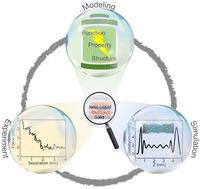当前位置:
X-MOL 学术
›
Nanoscale Horiz.
›
论文详情
Our official English website, www.x-mol.net, welcomes your feedback! (Note: you will need to create a separate account there.)
Integrative studies of ionic liquid interface layers: bridging experiments, theoretical models and simulations
Nanoscale Horizons ( IF 9.7 ) Pub Date : 2024-02-10 , DOI: 10.1039/d4nh00007b Rong An 1 , Nanhua Wu 2 , Qingwei Gao 3 , Yihui Dong 4 , Aatto Laaksonen 5, 6, 7, 8 , Faiz Ullah Shah 9 , Xiaoyan Ji 5 , Harald Fuchs 1, 10
Nanoscale Horizons ( IF 9.7 ) Pub Date : 2024-02-10 , DOI: 10.1039/d4nh00007b Rong An 1 , Nanhua Wu 2 , Qingwei Gao 3 , Yihui Dong 4 , Aatto Laaksonen 5, 6, 7, 8 , Faiz Ullah Shah 9 , Xiaoyan Ji 5 , Harald Fuchs 1, 10
Affiliation

|
Ionic liquids (ILs) are a class of salts existing in the liquid state below 100 °C, possessing low volatility, high thermal stability as well as many highly attractive solvent and electrochemical capabilities, etc., making them highly tunable for a great variety of applications, such as lubricants, electrolytes, and soft functional materials. In many applications, ILs are first either physi- or chemisorbed on a solid surface to successively create more functional materials. The functions of ILs at solid surfaces can differ considerably from those of bulk ILs, mainly due to distinct interfacial layers with tunable structures resulting in new ionic liquid interface layer properties and enhanced performance. Due to an almost infinite number of possible combinations among the cations and anions to form ILs, the diversity of various solid surfaces, as well as different external conditions and stimuli, a detailed molecular-level understanding of their structure–property relationship is of utmost significance for a judicious design of IL–solid interfaces with appropriate properties for task-specific applications. Many experimental techniques, such as atomic force microscopy, surface force apparatus, and so on, have been used for studying the ion structuring of the IL interface layer. Molecular Dynamics simulations have been widely used to investigate the microscopic behavior of the IL interface layer. To interpret and clarify the IL structure and dynamics as well as to predict their properties, it is always beneficial to combine both experiments and simulations as close as possible. In another theoretical model development to bridge the structure and properties of the IL interface layer with performance, thermodynamic prediction & property modeling has been demonstrated as an effective tool to add the properties and function of the studied nanomaterials. Herein, we present recent findings from applying the multiscale triangle “experiment–simulation–thermodynamic modeling” in the studies of ion structuring of ILs in the vicinity of solid surfaces, as well as how it qualitatively and quantitatively correlates to the overall ILs properties, performance, and function. We introduce the most common techniques behind “experiment–simulation–thermodynamic modeling” and how they are applied for studying the IL interface layer structuring, and we highlight the possibilities of the IL interface layer structuring in applications such as lubrication and energy storage.
中文翻译:

离子液体界面层的综合研究:桥联实验、理论模型和模拟
离子液体(IL)是一类在100℃以下以液态存在的盐,具有低挥发性、高热稳定性以及许多极具吸引力的溶剂和电化学功能等,使其具有高度可调性,可用于多种用途。应用,例如润滑剂、电解质和软功能材料。在许多应用中,离子液体首先被物理或化学吸附在固体表面上,以相继产生更多功能的材料。固体表面离子液体的功能与本体离子液体的功能有很大不同,这主要是由于具有可调结构的不同界面层导致新的离子液体界面层特性和增强的性能。由于形成离子液体的阳离子和阴离子之间几乎有无数种可能的组合、各种固体表面的多样性以及不同的外部条件和刺激,因此在分子水平上详细了解其结构-性质关系至关重要明智地设计 IL-solid 接口,并为特定任务的应用程序提供适当的属性。许多实验技术,如原子力显微镜、表面力装置等,已被用于研究离子液体界面层的离子结构。分子动力学模拟已广泛用于研究 IL 界面层的微观行为。为了解释和阐明 IL 结构和动力学并预测其特性,尽可能紧密地结合实验和模拟总是有益的。在另一个将 IL 界面层的结构和性能与性能联系起来的理论模型开发中,热力学预测和性能建模已被证明是添加所研究纳米材料的性能和功能的有效工具。在此,我们介绍了在固体表面附近的离子液体的离子结构研究中应用多尺度三角“实验-模拟-热力学模型”的最新发现,以及它如何定性和定量地与整体离子液体性质、性能相关联。和函数。我们介绍了“实验-模拟-热力学建模”背后最常见的技术,以及如何将它们应用于研究IL界面层结构,并强调了IL界面层结构在润滑和储能等应用中的可能性。
更新日期:2024-02-15
中文翻译:

离子液体界面层的综合研究:桥联实验、理论模型和模拟
离子液体(IL)是一类在100℃以下以液态存在的盐,具有低挥发性、高热稳定性以及许多极具吸引力的溶剂和电化学功能等,使其具有高度可调性,可用于多种用途。应用,例如润滑剂、电解质和软功能材料。在许多应用中,离子液体首先被物理或化学吸附在固体表面上,以相继产生更多功能的材料。固体表面离子液体的功能与本体离子液体的功能有很大不同,这主要是由于具有可调结构的不同界面层导致新的离子液体界面层特性和增强的性能。由于形成离子液体的阳离子和阴离子之间几乎有无数种可能的组合、各种固体表面的多样性以及不同的外部条件和刺激,因此在分子水平上详细了解其结构-性质关系至关重要明智地设计 IL-solid 接口,并为特定任务的应用程序提供适当的属性。许多实验技术,如原子力显微镜、表面力装置等,已被用于研究离子液体界面层的离子结构。分子动力学模拟已广泛用于研究 IL 界面层的微观行为。为了解释和阐明 IL 结构和动力学并预测其特性,尽可能紧密地结合实验和模拟总是有益的。在另一个将 IL 界面层的结构和性能与性能联系起来的理论模型开发中,热力学预测和性能建模已被证明是添加所研究纳米材料的性能和功能的有效工具。在此,我们介绍了在固体表面附近的离子液体的离子结构研究中应用多尺度三角“实验-模拟-热力学模型”的最新发现,以及它如何定性和定量地与整体离子液体性质、性能相关联。和函数。我们介绍了“实验-模拟-热力学建模”背后最常见的技术,以及如何将它们应用于研究IL界面层结构,并强调了IL界面层结构在润滑和储能等应用中的可能性。



























 京公网安备 11010802027423号
京公网安备 11010802027423号